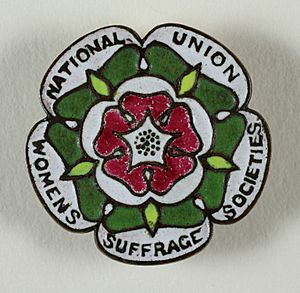Harriet Leisk facts for kids
Quick facts for kids
Harriet Atherton Leisk
|
|
|---|---|
| Born |
Harriet Ann Atherton
10 August 1853 |
| Died | 3 July 1921 Gilbert Bain Hospital, Lerwick
|
| Occupation | Suffragist |
| Organization | Shetland Women's Suffrage Society, Emergency Helpers |
| Spouse(s) | John Leisk |
Harriet Atherton Leisk (born August 10, 1853 – died July 3, 1921) was an important suffragist from Shetland. A suffragist is someone who works to get voting rights for others, especially women. Harriet played a big part in the Shetland Women's Suffrage Society. During World War I, she also helped organize a group called the 'Emergency Helpers'. This group did volunteer war work and raised money for a special hospital called the Scottish Women's Hospital at Royaumont.
Contents
Harriet's Early Life
Harriet Atherton was born in Liverpool on August 10, 1853. Her parents were William and Harriet Goulborn Atherton. In 1874, she married John Leisk, who owned a fabric shop. They had five daughters: Ann, Alice, Harriet, Ethel, and Margaret. Her husband, John Leisk, was the leader of Lerwick, known as the Provost, from 1895 to 1904.
Fighting for the Vote and War Help
Harriet Leisk was the leader of the Shetland Women's Suffrage Society. This group started in 1909 at the home of Christina Jamieson. The society was connected to a larger group called the National Union of Women's Suffrage Societies. They worked to get women the right to vote.
They did this by holding public meetings, handing out leaflets, and writing letters to local newspapers. This calm approach seemed to work well in the Shetland Isles. Many people in Shetland supported the idea of women voting. In 1912, a man wrote to the Shetland News newspaper saying: "The local suffragists have been doing a lot of quiet, but very effective work... they have in many unobtrusive ways brought their views before others and have succeeded in securing many supporters." The Shetland group chose not to use forceful or violent methods in their campaign.
One important reason the Shetland women gave for women to vote was about seamen. Many men from Shetland worked as sailors and were often away at sea. This meant they couldn't vote. The women argued that if wives and relatives could vote, they could help make laws that would protect seamen's wages, safety, and lives.
The Emergency Helpers
When World War I began, the Shetland Women's Suffrage Society created a new group called the Emergency Helpers. Harriet Leisk was in charge of this group. The Helpers mainly focused on getting ready in case people were hurt in the war. They collected and made supplies like bandages and blankets. They also offered nursing training and first aid classes.
The Emergency Helpers also raised money for the Scottish Women's Hospital at Royaumont. This hospital helped wounded soldiers. The Helpers collected over £200 during the war. This money helped pay for a special hospital bed called the 'Lerwick Bed'. The Emergency Helpers continued their work throughout the war and stopped in May 1919.
Harriet's Later Life and Legacy
Harriet Leisk passed away on July 3, 1921, at the Gilbert Bain Hospital in Lerwick.
In 2021, Harriet Leisk was honored along with other Scottish suffragists. Their pictures and stories were put on a special deck of cards. These cards were given to 100 schools across Scotland as part of an education pack. This helped teach students about important women who fought for change.


